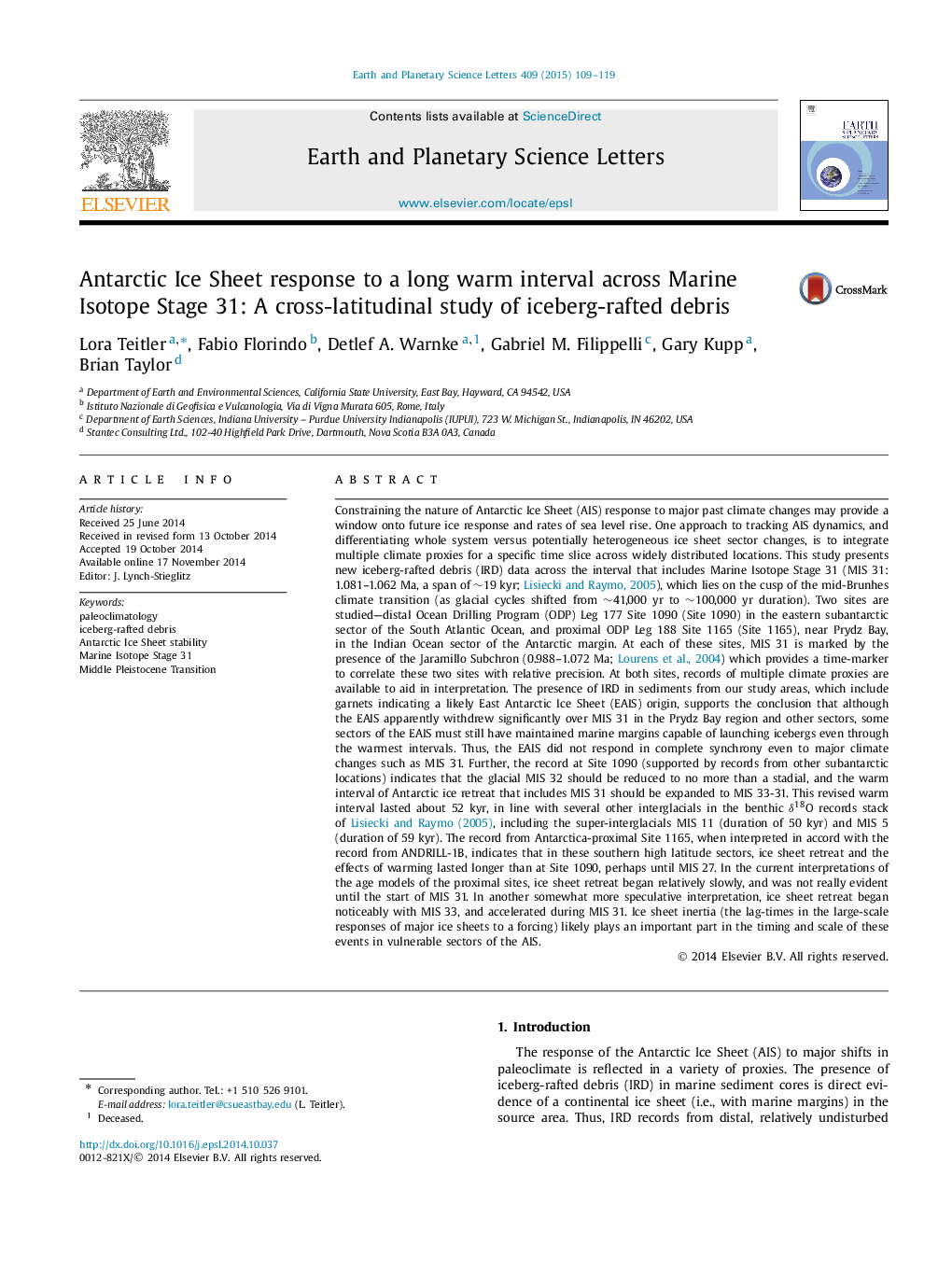| کد مقاله | کد نشریه | سال انتشار | مقاله انگلیسی | نسخه تمام متن |
|---|---|---|---|---|
| 6428823 | 1634747 | 2015 | 11 صفحه PDF | دانلود رایگان |
• This wide-area study of IRD, other climate proxies tracks AIS response around MIS 31.
• The Jaramillo Subchron provides a time marker to correlate these and other sites.
• Different sectors of AIS respond in an asynchronous manner to major climate shifts.
• The warm interval including MIS 31 should be expanded to MIS 33-31, lasting 52 kyr.
• Ice sheet inertia is a major factor in the response of the AIS to climate shifts.
Constraining the nature of Antarctic Ice Sheet (AIS) response to major past climate changes may provide a window onto future ice response and rates of sea level rise. One approach to tracking AIS dynamics, and differentiating whole system versus potentially heterogeneous ice sheet sector changes, is to integrate multiple climate proxies for a specific time slice across widely distributed locations. This study presents new iceberg-rafted debris (IRD) data across the interval that includes Marine Isotope Stage 31 (MIS 31: 1.081–1.062 Ma, a span of ∼19 kyr; Lisiecki and Raymo, 2005), which lies on the cusp of the mid-Brunhes climate transition (as glacial cycles shifted from ∼41,000 yr to ∼100,000 yr duration). Two sites are studied—distal Ocean Drilling Program (ODP) Leg 177 Site 1090 (Site 1090) in the eastern subantarctic sector of the South Atlantic Ocean, and proximal ODP Leg 188 Site 1165 (Site 1165), near Prydz Bay, in the Indian Ocean sector of the Antarctic margin. At each of these sites, MIS 31 is marked by the presence of the Jaramillo Subchron (0.988–1.072 Ma; Lourens et al., 2004) which provides a time-marker to correlate these two sites with relative precision. At both sites, records of multiple climate proxies are available to aid in interpretation. The presence of IRD in sediments from our study areas, which include garnets indicating a likely East Antarctic Ice Sheet (EAIS) origin, supports the conclusion that although the EAIS apparently withdrew significantly over MIS 31 in the Prydz Bay region and other sectors, some sectors of the EAIS must still have maintained marine margins capable of launching icebergs even through the warmest intervals. Thus, the EAIS did not respond in complete synchrony even to major climate changes such as MIS 31. Further, the record at Site 1090 (supported by records from other subantarctic locations) indicates that the glacial MIS 32 should be reduced to no more than a stadial, and the warm interval of Antarctic ice retreat that includes MIS 31 should be expanded to MIS 33-31. This revised warm interval lasted about 52 kyr, in line with several other interglacials in the benthic δO18 records stack of Lisiecki and Raymo (2005), including the super-interglacials MIS 11 (duration of 50 kyr) and MIS 5 (duration of 59 kyr). The record from Antarctica-proximal Site 1165, when interpreted in accord with the record from ANDRILL-1B, indicates that in these southern high latitude sectors, ice sheet retreat and the effects of warming lasted longer than at Site 1090, perhaps until MIS 27. In the current interpretations of the age models of the proximal sites, ice sheet retreat began relatively slowly, and was not really evident until the start of MIS 31. In another somewhat more speculative interpretation, ice sheet retreat began noticeably with MIS 33, and accelerated during MIS 31. Ice sheet inertia (the lag-times in the large-scale responses of major ice sheets to a forcing) likely plays an important part in the timing and scale of these events in vulnerable sectors of the AIS.
Journal: Earth and Planetary Science Letters - Volume 409, 1 January 2015, Pages 109–119
